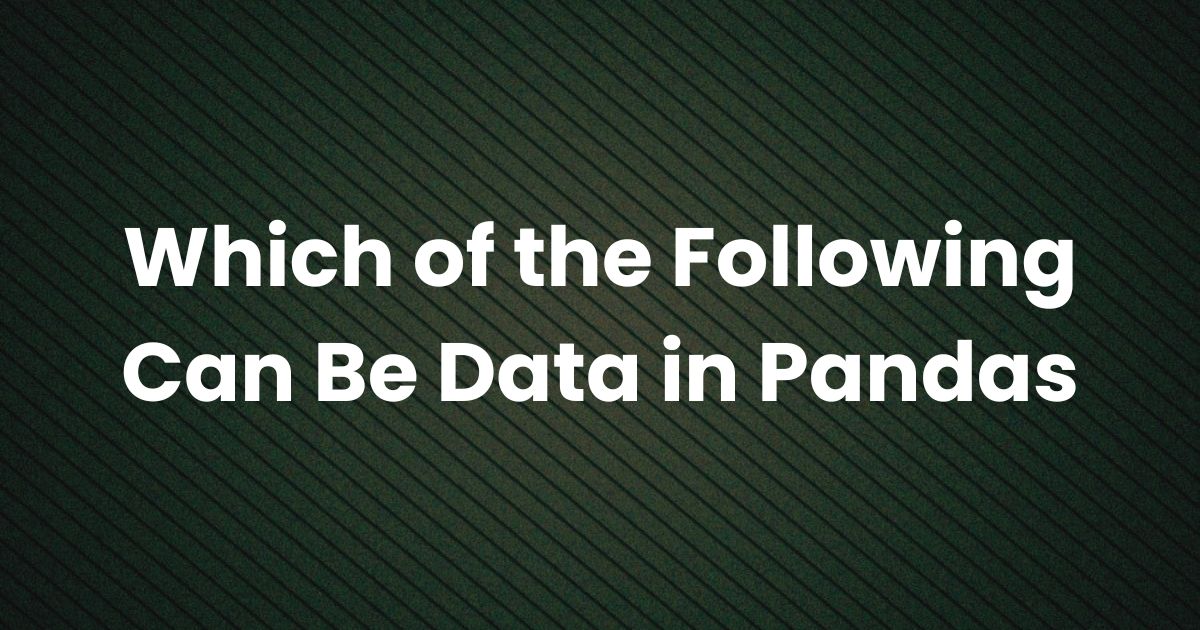
The straightforward solution is that Pandas can work with nearly any structured data format, including but not limited to CSV files, Excel spreadsheets, SQL database queries, dictionaries, lists, and NumPy arrays. In this article, we’ll explore the diverse range of data types and structures that can be used in Pandas, how they are converted into DataFrames or Series, and the flexibility that makes Pandas a powerful tool for data manipulation and analysis.
Introduction
Pandas is one of the most popular libraries in Python for data analysis and manipulation. One of its greatest strengths is the ability to read, process, and analyze data from a wide variety of sources and formats. Whether your data is stored in a text file, an Excel sheet, a database, or even generated on the fly as a list or dictionary, Pandas provides the functionality to convert it into a DataFrame—a two-dimensional, tabular data structure that is easy to work with.
Understanding which “things” can be data in Pandas helps you decide how best to import, clean, and analyze your datasets, regardless of their original format.
Types of Data That Pandas Can Handle
1. File Formats
- CSV (Comma-Separated Values) Files:
One of the most common data formats, CSV files can be read into a Pandas DataFrame using thepd.read_csv()function. - Excel Files:
Pandas provides thepd.read_excel()function to import data from Excel spreadsheets, supporting multiple sheets and various file formats (e.g.,.xlsand.xlsx). - JSON (JavaScript Object Notation):
Data in JSON format can be imported withpd.read_json(), which is especially useful for data coming from web APIs. - HTML Tables:
Using thepd.read_html()function, you can extract tables directly from HTML pages into DataFrames. - Text Files:
Plain text files with structured data (e.g., tab-separated values, fixed-width formatted files) can be read using functions likepd.read_table().
2. Data Structures in Python
- Dictionaries:
Python dictionaries, especially those where the keys represent column names and the values are lists (or arrays) of data, can be directly converted into a DataFrame usingpd.DataFrame(). - Lists and Lists of Lists:
A list of lists, where each inner list represents a row of data, can be converted into a DataFrame. You can also create a Series from a single list. - NumPy Arrays:
Since Pandas is built on top of NumPy, NumPy arrays can easily be converted into DataFrames or Series usingpd.DataFrame()orpd.Series(), making it seamless to move between numerical computations and data analysis.
3. Database Connections
- SQL Queries:
Pandas provides functions such aspd.read_sql_query()andpd.read_sql_table()to execute SQL queries and retrieve data directly into a DataFrame from a database connection. This is very useful for working with large datasets stored in relational databases.
4. Other Data Sources
- Clipboard:
You can usepd.read_clipboard()to capture data copied to your clipboard, which is handy for quick data analysis tasks. - Parquet, HDF5, and Other Binary Formats:
For handling large datasets efficiently, Pandas supports several binary formats such as Parquet (pd.read_parquet()), HDF5 (pd.read_hdf()), and others, which offer faster read/write times compared to text-based formats.
Flexibility and Conversion
Automatic Type Inference
When importing data, Pandas automatically infers data types (e.g., integer, float, string, datetime) for each column, which simplifies the process of data cleaning and manipulation. This automatic inference helps ensure that the data is in a usable format for further analysis.
Custom Conversions
In cases where automatic type inference is not sufficient, you can specify data types explicitly using parameters such as dtype in functions like pd.read_csv(). This ensures that the data is accurately represented and can be manipulated as needed.
Real-World Applications
Data Analysis
From financial data and scientific experiments to social science surveys and web analytics, Pandas can import and process data from various sources, making it a versatile tool for any data analysis project.
Machine Learning
Pandas is widely used in machine learning workflows for data preprocessing, cleaning, and exploration. Its ability to handle diverse data formats makes it integral to preparing datasets for training models.
Reporting and Visualization
After processing data with Pandas, you can easily export DataFrames to Excel, CSV, or JSON formats, or directly plot graphs using libraries like Matplotlib or Seaborn. This streamlines the process of generating reports and visualizing trends.
Conclusion
In conclusion, Pandas can handle data from an impressive range of sources, including CSV files, Excel spreadsheets, JSON files, HTML tables, Python dictionaries, lists, NumPy arrays, SQL databases, and even binary formats like Parquet and HDF5. This flexibility is one of the key strengths of Pandas, enabling developers, data scientists, and analysts to work seamlessly with diverse datasets and transform them into powerful, manipulable DataFrames for analysis and visualization.
Understanding the variety of data formats that Pandas can process allows you to choose the right tools and methods for your specific project, making your data analysis work more efficient and effective.
Disclaimer: This article is intended for informational and educational purposes only. The techniques and examples discussed are based on current best practices in data analysis with Pandas. For more detailed or specialized information, readers are encouraged to consult official Pandas documentation and additional data science resources.
Also Check:
• Which Keyword Can Be Used for Coming Out of Recursion? An In-Depth Exploration
• Which of the Given Molecules Can Exhibit Tautomerism? An In-Depth Analysis
• Which Property of a Proton Can Change? An In-Depth Exploration
• Which Attribute Can Hold the JavaScript Version? An In-Depth Exploration




2 thoughts on “Which of the Following Can Be Data in Pandas? An In-Depth Exploration”